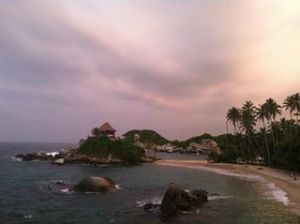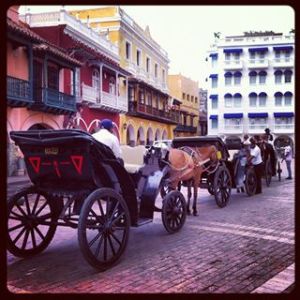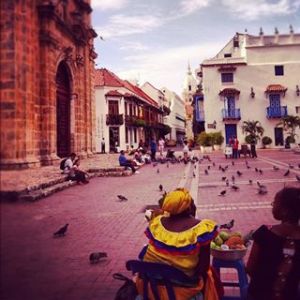When I told most people about my Colombia travel plans, most stared blankly at me and said, “You’re going to Colombia? Why?” It’s a country whose recent marred history has made it a bit of a tourist detraction. On the other hand, intrepid travelers continue to list it as one of their “must see” destinations. Its disparate reputation made me all the more curious, and eager to discover for myself. Needless to say, it exceeded my expectations. Colombia’s sheer and diverse beauty, vibrant culture, and amazing people left me taken aback, and eager to set the record straight on its poor repute.
BOGOTA aka Spanish Colonial Brooklyn:
Hailing from a city appropriately dubbed, “The Mile High,” I have a certain appreciation for cities with thin air. Entering Bogota, I was pleasantly surprised to discover that the city is cradled in the Andes, unlike Denver whose mountains hover on the horizon. Monseratte is located at its summit, and presides over the sprawling city and its 10 million inhabitants. Take the tram to the top of Monseratte, where you can attempt to grasp the vastness of Bogota, and life at 10,341 feet. 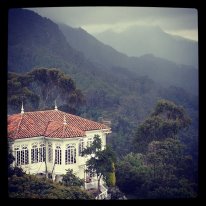 Most budget travelers opt to stay in La Candelaria, whereas high end travelers stay in La Zona Rosa. La Candelaria is located in Bogota’s historic district, and is a fun area to explore during the day with its museums, colorful graffiti, and Spanish colonial architecture. At the Museo Botero, you’ll find it hard to conceal a smile as you stroll through its galleries of happy, full-figured Colombians. Beyond Botero, the collection is top notch. The Museo del Oro is another impressive display of the country’s finest offerings, and provides you with some insight into the legend of El Dorado (make sure not to miss the Muisca raft.) If you want to explore the legend of El Dorado further, Lake Guatavita is located about 35 miles Northeast of Bogota, and is supposedly the site where El Dorado dusted himself in gold, and worshipers threw their own gold into the lake. The lake is mighty unimpressive, since two separate parties have attempted to drain it in hopes of discovering gold. Shortly after, they filed for bankruptcy. We combined our trip to Lake Guatavita with The Salt Cathedral (Catedral de Sal deZipaquirá), and the latter half of our trip was well worth the time it took to get there. The Salt Cathedral is an underground Roman Catholic Church built within the tunnels of a salt mine, and thanks to a little neon lighting, it’s no wonder thousands of people make pilgrimages here. Last but not least, Andreas Carne de Res, also known as Andres D.C. offers “the best of Colombia” all rolled up into one. It’s really a steakhouse, but that label doesn’t do justice to this 4-story entertainment mecca. There are two locations: the original location in Chia (a 40-minute cab ride from Bogota), or one in La Zona Rosa. Both locations will be jam-packed, so be sure to make reservations beforehand. You might as well initiate yourself into Colombian dining at Andres D.C. by ordering an arepa (a white corn patty ranging in style, shape, and size throughout Colombia), and slug it down with a bottle of aguardiente (pretty nasty anise-flavored liquor). You’ll be dancing alongside the Colombians in no time.
Most budget travelers opt to stay in La Candelaria, whereas high end travelers stay in La Zona Rosa. La Candelaria is located in Bogota’s historic district, and is a fun area to explore during the day with its museums, colorful graffiti, and Spanish colonial architecture. At the Museo Botero, you’ll find it hard to conceal a smile as you stroll through its galleries of happy, full-figured Colombians. Beyond Botero, the collection is top notch. The Museo del Oro is another impressive display of the country’s finest offerings, and provides you with some insight into the legend of El Dorado (make sure not to miss the Muisca raft.) If you want to explore the legend of El Dorado further, Lake Guatavita is located about 35 miles Northeast of Bogota, and is supposedly the site where El Dorado dusted himself in gold, and worshipers threw their own gold into the lake. The lake is mighty unimpressive, since two separate parties have attempted to drain it in hopes of discovering gold. Shortly after, they filed for bankruptcy. We combined our trip to Lake Guatavita with The Salt Cathedral (Catedral de Sal deZipaquirá), and the latter half of our trip was well worth the time it took to get there. The Salt Cathedral is an underground Roman Catholic Church built within the tunnels of a salt mine, and thanks to a little neon lighting, it’s no wonder thousands of people make pilgrimages here. Last but not least, Andreas Carne de Res, also known as Andres D.C. offers “the best of Colombia” all rolled up into one. It’s really a steakhouse, but that label doesn’t do justice to this 4-story entertainment mecca. There are two locations: the original location in Chia (a 40-minute cab ride from Bogota), or one in La Zona Rosa. Both locations will be jam-packed, so be sure to make reservations beforehand. You might as well initiate yourself into Colombian dining at Andres D.C. by ordering an arepa (a white corn patty ranging in style, shape, and size throughout Colombia), and slug it down with a bottle of aguardiente (pretty nasty anise-flavored liquor). You’ll be dancing alongside the Colombians in no time.
CARTAGENA
Cartagena is the crown jewel of the Caribbean, and as such has been fighting to preserve the beauty within its walls since the days of Sir Francis Drake. The ideal climate and strategic location have made it a popular place to live and visit. Cartagena today has expanded beyond the walls of the old city, spilling over into the outer city, and the Bocagrande peninsula. I loved waking up amid the hustle and bustle in the old city in search of fresh fruit (the fruit vendors are a work of art in themselves), coffee, and cheesy bread (pandebono or pan con queso mozzarella can be found in any of the panaderias). It seemed that every time I set out to do something in Cartagena, I willingly found myself lost within its labyrinth of cobbled alleys. The vibrant façades and blooming bougainvillea are just a few distractions, and rather than view the city through the lens of a camera, you have to remind yourself to take in its magico realismo (ahem, Gabriel Garcia Marquez). I happened upon a few of my favorite places during my aimless wanderings, and frequented them for the remainder of my stay. La Mulata (Calle Quero No 9-58 El Centro) is an unmarked restaurant off Calle Quero that offers commida corriente (a set lunch menu), and the food is fresh, tasty, and very affordable. If you do happen to find it, don’t skip out on their fresh juice- any of them are amazing! I was watching Anthony Bourdain’s No Reservations: Colombia before leaving, and he mentioned a place called “La Cevicheria.” I must’ve passed it three times before realizing it was THE Cevicheria (Calle Stuart No 7-14 San Diego) . If it was a favorite of Mr. Bourdain’s, I figured I should try it. The menu items change weekly, but are all inspired and unique to Cartagena- fish caught just off the shore mixed in with lime juice, garlic and fresh fruits (two fruits you need to try are lulo and moro). The last place was Abaco Libros (Calle de la Iglesia con Calle de la Mantilla esquina No. 3-86 Local 3) a charming and quaint bookstore where you can go to collect your thoughts, or discuss the days plans over a cup of coffee, or an Aguila beer. There are two other touristy places that are great to go for a drink and people watch- Café del Mar is a bar on the ramparts of the old city where the cocktails are expensive but the views worth it (Bocagrande in the distance, with the sun setting on the Caribbean), and the plaza de los coches where you can grab a cheaper drink and sit back and take in the city. If you are looking for a daytime activity, and would prefer to get out of Cartagena, you can take a 40-50 minute boat ride to the Rosario Islands for snorkeling and hiking.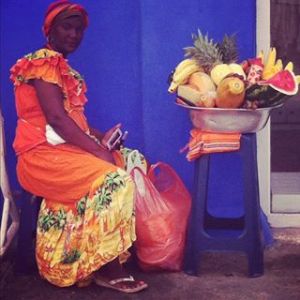
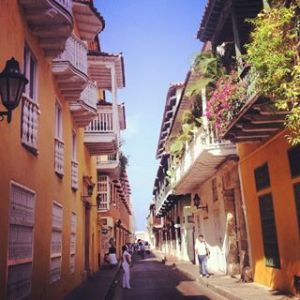
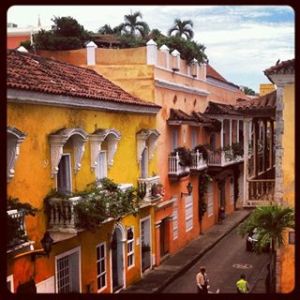
SANTA MARTA/PARQUE TAYRONA
Santa Marta is the gateway to Parque Tayrona and also Ciudad Perdida. I wouldn’t recommend spending more than 2 days here unless it’s for rest and recovery. For our trip from Cartagena to Santa Marta, we used the bus company, El Mirasol, mainly because they offer door-to-door pickup/drop off. The La Brisa Loca hostel has a monopoly on Santa Marta’s backpacker accommodations, and for good reason. It’s owned by two well-traveled brothers from California, and they strike a nice balance between the two Americas. If you don’t end up spending all your waking moments at the hostel, you’ll be surprised by all the fun and classy dining options in Santa Marta. The Mexican restaurant below the hostel, Agaves Azul is delicious and has a two-for-one happy hour. Ouzo is another restaurant in town that’s a bit nicer, and offers some amazing Mediterranean dishes with really tender meat. The next town over from Santa Marta is Taganga, and it’s a small/somewhat sketchy town but offers good diving and there’s a bar/hotel called El Mirador that provides some quality entertainment. You can take a cab from Santa Marta to El Mirador (just tell the driver ‘El Mirador’ and they’ll know), and once you’re there, sit back and take in the views of the harbor and be amazed by how the locals can move their hips. That’s about it for Santa Marta, unless you care to see where Simon Bolivar spent his last days.
Before we left for Parque Tayrona, we went to the grocery store in Santa Marta and stocked up on food and supplies, making sure not to forget bug spray. There are places to eat at each beach inside Parque Tayrona, but they hike the prices up, so we backpacked in with enough food and water to last 2 days. We caught the local bus from the market in Santa Marta (Calle 11, Carrera 11), and took it for 45 minutes until the entrance to Parque Tayrona. The driver didn’t give us any indication that we had reached the park, so keep your eyes peeled for the sign, or make friends with someone who can tell you where to get off. Once you get dropped off, you’ll have to pay an entrance fee for the park, and the Colombianpolice will do a verrryyyyy thorough search of you and all of your belongings. The trip through the jungle is a small adventure in itself, and the trail is heavily trafficked- mainly by horses, so make sure you’re wearing multi-terrain (horse shit, sand, mud, etc) footwear. It should take you an hour and a half or more to reach the first beach, Arrecifes, and once you reach Arrecifes prepare to spend the remainder of your time in Parque Tayrona amazed. From Arrecifes, follow the signs to Cabo San Juan. Cabo is set in a deep bay, and has tents and hammocks (low or high, high is for rent. Since there were only two of us (in a non-domestic partnership), we went the hammock route. The view from our hammocks was incredible, but I hardly slept at all that night. Instead, I passed out on the beach and got a ridiculous burn on my ass the next day. Don’t do this. 